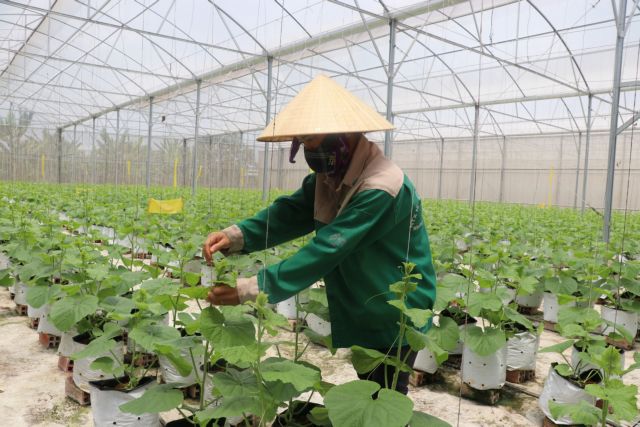
LONG AN – The Cửu Long (Mekong) Delta province of Long An plans to switch to other crops on around 8,500ha of unproductive rice fields before year-end.
Some 6,800ha will be used for short-term crops and the rest for perennial trees.
The fields are located mostly in Vĩnh Hưng, Tân Hưng, Đức Huệ and Tân Trụ districts.
To effectively convert them, the province Department of Agriculture and Rural Development has instructed local authorities to take comprehensive measures and ensure adaptation to climate change.
They should also ensure that the rice seedlings they choose are of high quality, offer high yields, are resistant to diseases, and suitable for local conditions, it said.
It is instructing households in techniques for switching to other crops.
It has called on companies to link up with farmers for producing and consuming agricultural products and for supplying them with quality inputs including seedlings.
In the 2021 – 22 winter-spring crop, the province switched to other crops like watermelon, sesame, sweet potato, and fruits on 2,000ha of paddies.
But it has not proved sustainable because of lack of steady outlets and prices and not following local zoning plan, according to localities.
Infrastructure has not met the conversion requirements.
In recent years local authorities have taken measures to improve the incomes of farmers switching to other crops such as promoting linkages with companies to guarantee steady prices.
The province plans to convert a total of 54,000ha in 2021 – 25.
In 2017 – 20 nearly 20,000ha were converted, and they now have other crops like sesame, corn, watermelon, peanut, grapefruit, soursop, durian, jackfruit, pineapple, and lime.
They provide 1.5 – 4 times higher incomes than rice, according to the department.
Hi-tech agriculture
Long An, one of the delta’s largest rice producers, uses hi-tech farming on nearly 30,000ha of rice, 1,800ha of vegetables, 300ha of lime, and 3,000ha of dragon fruit under a programme that combines this with building new-style rural areas beginning in 2016.
Rice farmers use certified seeds and pesticides in proper quantities and machines in all stages to reduce labour costs and improve yield and quality.
Nguyễn Văn Bình of Vĩnh Hưng District’s Khánh Hưng Commune is a hi-tech farmer with 5ha.
His costs had reduced by VNĐ3 – 7 million (US$130 – 300) per hectare per crop compared to traditional farming, he said.
“I earn a profit for every rice crop.”
The department has also developed 47 co-operatives and co-operative groups that use technology.
Lê Văn Tại, director of the Resfuot Agriculture Co-operative in Tân Thạnh District’s Tân Lập Commune, said members were instructed to use technology and Vietnamese good agricultural practices (VietGAP) standards to grow grapefruits for exporting to the EU.
The department helped the co-operative build a 5,000sq.m warehouse to store fruits, he added.
Bùi Quốc Bảo, secretary of the Tân Thạnh Party Committee, said farmers in the district had switched to growing fruits on more than 1,000ha of unproductive rice fields using hi-tech methods.
The district is zoning its fruit growing areas into hi-tech speciality fruit growing ones with linkages between various stakeholders and tourism services.
The province plans to expand hi-tech farming by 2025, applying it on 60,000ha of rice, 6,000ha of dragon fruit, 2,000ha of vegetables, 3,000ha of lime, and 1,000ha of brackish shrimp.
It also plans to develop seven hi – tech agricultural zones for cultivating rice, one for lime and one for dragon fruit for exports by 2025.
It hopes hi-tech farming would increase incomes by 10 per cent. – – VnExpress News
- Reduce Hair Loss with PURA D’OR Gold Label Shampoo
- Castor Oil Has Made a “Huge” Difference With Hair and Brow Growth
- Excessive hair loss in men: Signs of illness that cannot be subjective
- Dịch Vụ SEO Website ở Los Angeles, CA: đưa trang web doanh nghiệp bạn lên top Google
- Nails Salon Sierra Madre
 VnExpress News The News Gateway of Vietnam
VnExpress News The News Gateway of Vietnam





